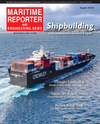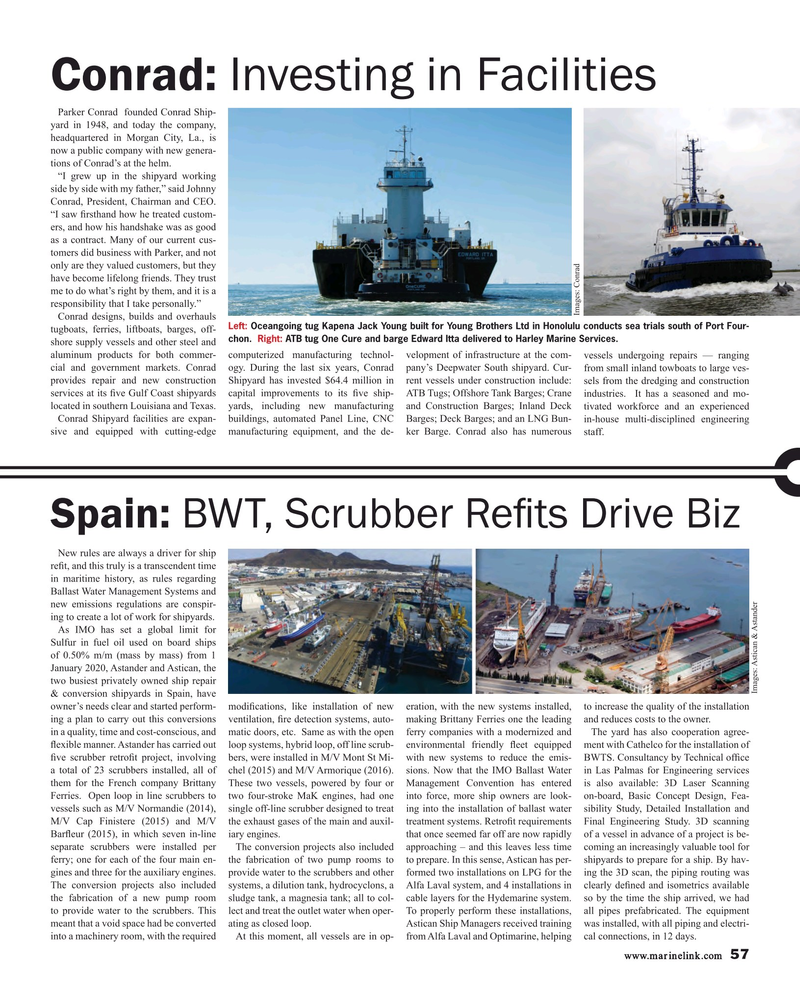
Page 57: of Maritime Reporter Magazine (August 2018)
The Shipyard Edition
Read this page in Pdf, Flash or Html5 edition of August 2018 Maritime Reporter Magazine
Conrad: Investing in Facilities
Parker Conrad founded Conrad Ship- yard in 1948, and today the company, headquartered in Morgan City, La., is now a public company with new genera- tions of Conrad’s at the helm. “I grew up in the shipyard working side by side with my father,” said Johnny
Conrad, President, Chairman and CEO. “I saw ? rsthand how he treated custom- ers, and how his handshake was as good as a contract. Many of our current cus- tomers did business with Parker, and not only are they valued customers, but they have become lifelong friends. They trust me to do what’s right by them, and it is a responsibility that I take personally.”
Images: Conrad
Conrad designs, builds and overhauls
Left: Oceangoing tug Kapena Jack Young built for Young Brothers Ltd in Honolulu conducts sea trials south of Port Four- tugboats, ferries, liftboats, barges, off- chon. Right: ATB tug One Cure and barge Edward Itta delivered to Harley Marine Services.
shore supply vessels and other steel and aluminum products for both commer- computerized manufacturing technol- velopment of infrastructure at the com- vessels undergoing repairs — ranging cial and government markets. Conrad ogy. During the last six years, Conrad pany’s Deepwater South shipyard. Cur- from small inland towboats to large ves- provides repair and new construction Shipyard has invested $64.4 million in rent vessels under construction include: sels from the dredging and construction services at its ? ve Gulf Coast shipyards capital improvements to its ? ve ship- ATB Tugs; Offshore Tank Barges; Crane industries. It has a seasoned and mo- located in southern Louisiana and Texas. yards, including new manufacturing and Construction Barges; Inland Deck tivated workforce and an experienced
Conrad Shipyard facilities are expan- buildings, automated Panel Line, CNC Barges; Deck Barges; and an LNG Bun- in-house multi-disciplined engineering sive and equipped with cutting-edge manufacturing equipment, and the de- ker Barge. Conrad also has numerous staff.
Spain: BWT, Scrubber Re? ts Drive Biz
New rules are always a driver for ship re? t, and this truly is a transcendent time in maritime history, as rules regarding
Ballast Water Management Systems and new emissions regulations are conspir- ing to create a lot of work for shipyards.
As IMO has set a global limit for
Sulfur in fuel oil used on board ships of 0.50% m/m (mass by mass) from 1
January 2020, Astander and Astican, the two busiest privately owned ship repair
Images: Astican & Astander & conversion shipyards in Spain, have owner’s needs clear and started perform- modi? cations, like installation of new eration, with the new systems installed, to increase the quality of the installation ing a plan to carry out this conversions ventilation, ? re detection systems, auto- making Brittany Ferries one the leading and reduces costs to the owner. in a quality, time and cost-conscious, and matic doors, etc. Same as with the open ferry companies with a modernized and The yard has also cooperation agree- ? exible manner. Astander has carried out loop systems, hybrid loop, off line scrub- environmental friendly ? eet equipped ment with Cathelco for the installation of ? ve scrubber retro? t project, involving bers, were installed in M/V Mont St Mi- with new systems to reduce the emis- BWTS. Consultancy by Technical of? ce a total of 23 scrubbers installed, all of chel (2015) and M/V Armorique (2016). sions. Now that the IMO Ballast Water in Las Palmas for Engineering services them for the French company Brittany These two vessels, powered by four or Management Convention has entered is also available: 3D Laser Scanning
Ferries. Open loop in line scrubbers to two four-stroke MaK engines, had one into force, more ship owners are look- on-board, Basic Concept Design, Fea- vessels such as M/V Normandie (2014), single off-line scrubber designed to treat ing into the installation of ballast water sibility Study, Detailed Installation and
M/V Cap Finistere (2015) and M/V the exhaust gases of the main and auxil- treatment systems. Retro? t requirements Final Engineering Study. 3D scanning
Bar? eur (2015), in which seven in-line iary engines. that once seemed far off are now rapidly of a vessel in advance of a project is be- separate scrubbers were installed per The conversion projects also included approaching – and this leaves less time coming an increasingly valuable tool for ferry; one for each of the four main en- the fabrication of two pump rooms to to prepare. In this sense, Astican has per- shipyards to prepare for a ship. By hav- gines and three for the auxiliary engines. provide water to the scrubbers and other formed two installations on LPG for the ing the 3D scan, the piping routing was
The conversion projects also included systems, a dilution tank, hydrocyclons, a Alfa Laval system, and 4 installations in clearly de? ned and isometrics available the fabrication of a new pump room sludge tank, a magnesia tank; all to col- cable layers for the Hydemarine system. so by the time the ship arrived, we had to provide water to the scrubbers. This lect and treat the outlet water when oper- To properly perform these installations, all pipes prefabricated. The equipment meant that a void space had be converted ating as closed loop. Astican Ship Managers received training was installed, with all piping and electri- into a machinery room, with the required At this moment, all vessels are in op- from Alfa Laval and Optimarine, helping cal connections, in 12 days.
www.marinelink.com 57
MR #8 (50-57).indd 57 MR #8 (50-57).indd 57 8/6/2018 11:07:01 AM8/6/2018 11:07:01 AM

 56
56

 58
58
